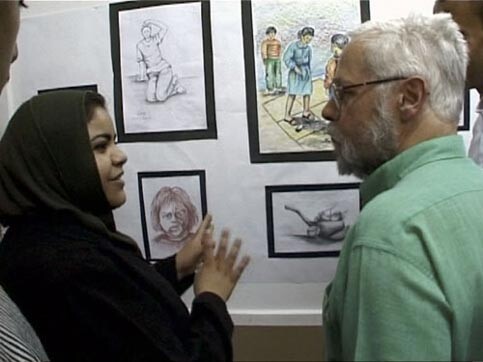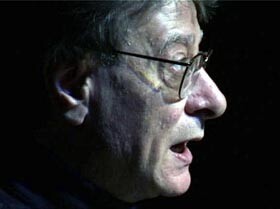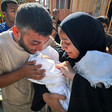The Electronic Intifada 3 June 2004

A scene from Remembering Palestine
Like every other aspect of Palestinian life, art and culture, though not destroyed have been crushed under the heavy weight of the Israeli occupation’s tanks and curfews. The documentary films Writers on the Borders and Remembering Palestine feature international writers and artists who visit Palestine and find a shocking landscape of destruction. But, as the narrator Dominique Dubosc explains in Remembering, the question is not so much one of succeeding to restart art schools in the West Bank and Gaza, as being there to bear witness. Like Mahmoud Darwish tells an assembly of writers in Borders, it’s about “carrying with us [the Palestinians] this burden of hope.”
Remembering Palestine is not really a documentary of the French artist Dubosc’s project to rebuild art schools in Palestine. It’s more of a video diary, which allows viewers to see the footage Dubosc captured in his travels around Ramallah, Jerusalem, and Gaza, and his drawings done in reaction to what he sees. While chronological, the film doesn’t embrace the usual linear form of narration. Instead of explaining what exactly is happening at an arts school in Gaza, the camera prefers to linger on each students’ hands instead of their art work or their conversation.
Dubosc is interested in the quiet parts of Palestinian life as much as the unpleasant imagery of Israeli tanks and helicopter missile strikes (the aftermath of which his camera records). The quietness of Ramallah under curfew is not something that can be explained in a newspaper article that emphasizes body counts, soundbites from politicians, and so on. In a vignette entitled “All of life on the rooftops,” viewers hear the rustling of ribbons tied on wires on rooftops, a cat meowing, and the muffled din of children playing indoors or in the alleyways.
But there is also a different kind of silence in Gaza, the silence of death after an Israeli missile drops on a car and strikes a boy, girl, and a young man, as is shown in the film. Dubosc records the sound of the helicopter in the air, but the footage of the bodies being pulled from the carnage is eerily silent. Although the film doesn’t provide any context other than the date, this missile strike was the one that assassinated Hamas leader Salah Shehadeh, along with 14 other Palestinians, including nine children.
Equally as powerful as the quiet scenes of disaster after the missile strike is Dubosc’s footage of kites dotting the sky, a daytime constellation for a people under curfew. The network of kites, flown by children from their rooftops, communicate hope, and serve as anonymous messages of unity defying the Israeli apache attack helicopters that all too often occupy the sky over Palestinian territory.

Mahmoud Darwish in Writers on the Borders
French writer Christian Salmon, to an audience of Palestinians, says he learned a new word while at a checkpoint earlier that day: “sabreen,” or patience. Because the Palestinians have so much patience, he says, the “future belongs to you.” And after being told by some elderly Palestinian women in the West Bank that Palestine is their right, and that Ariel Sharon is an ass, Salmon says, “of their words, I understood nothing,” adding, “this chorus of women was like that of the Greek tragedies.”
The writers are given tours of the West Bank and Gaza, and find that the way Palestinians are treated by the Israeli occupying forces is one of systematic mass punishment. A young woman in a refugee camp explains that when Israeli soldiers stationed themselves at her family’s house, “to impress us, they broke the T.V.” The writers see that not only is the T.V. smashed, but every wall in the home has a huge hole in it, as though the soldiers couldn’t be bothered with using any doors.
One of the saddest moments of the film is when the writers visit a Palestinian man whose olive tree groves are being chainsawed by some young, nervous-looking Israeli soldiers. While the chainsaw buzzes away, the sitting man wipes his tears, asking, “How will I feed my children now that they have taken everything?” Saying that all he has left is God and his land, the man adds that the soldiers are razing his land in order to build the so-called security wall. The man better describes it as “this wall of injustice, this racism.”
Upon visiting Birzeit University, the writers find that Palestinians must leave their vehicles at a roadblock and cross 500 meters of road to a taxi stand on the other side. “This is not a security measure but collective punishment,” one of the writers narrates. At Birzeit, the writers pen messages on a large pad. American Russell Banks writes, “The stones of Palestine have tongues. They speak. Listen to them!” Portuguese writer Jose Saramago jots, “A lack of water for this flower,” and sketches a little drawing of a daisy. A Palestinian writer tells his international peers, “what is shocking to you has become banal to us,” adding, “what shocks your conscience has become our daily lot.
One of the writers, who is not keen to meet heads of states, narrates how Yasser Arafat thrives in defeat and rises like a phoenix from the ashes. Upon meeting Arafat, the exiled Chinese poet Bei Dao says, “He [Arafat] too is a man who knows how to use metaphors. … Sharon’s language is blunt and straightforward, like that of a tank.”
Selgado causes controversy within the group and in Israel when he publicly declares, “I say that the Palestinians are living in a concentration camp situation,” upon seeing the destroyed homes in Rafah and the sprawling Jews-only settlements that have been illegally developed in the Palestinian territories. An elderly, gruff-voiced Israeli patiently explains to Selgado that comparisons of the way Palestinians experience occupation to the ways Jews were treated in Germany during WWII “shuts the ears of Israelis,” echoing what Israeli-American filmmaker B.Z. Goldberg tells Palestinian filmmaker Hany Abu Assad in Assad’s film Ford Transit.
Like he earlier wrote on the pad that the group of writers was there “for the recollection of the collapsed zones of language,” Christian Salmon explains that the discourse on the Israeli-Palestinian conflict is riddled with “stupid associations” and this is why writers are necessary, “to make other voices heard,” and to act as “a force of interpretation.”
One of the voices heard loud and clear is that of a man whose trees were torn up by Israelis in Gaza. He says, “If they destroy my house, I’ll live in a tent … for we will never leave this land as our parents did in ‘48.” He adds, “Kill us, expel us, starve us, exterminate us. Whatever you do, you will not conquer our will.” He laughs at the absurdity of how an Ethiopian Jew can come to Israel and in 24 hours have more legal rights over the land than he, a native Palestinian, does. “This land speaks Arabic and I speak Arabic,” he says.
And although the writers don’t speak Arabic, they understand the language of an occupied landscape that, as Salmon observes, has been dissolved by the piecemeal breakup of the territory. They understand the difference of driving on an Israeli-only road in the West Bank, which has yellow lines on the sides that keep settlers and soldiers from accidentally driving into a Palestinian village, versus driving on an un-paved, torn up Palestinian road that is controlled by Israeli soldiers that aren’t necessarily known for their charity. And little translation is needed when encountering a little boy in Rafah, sitting on a pile of concrete rubble, matter-of-factly stating, “This is our house.”
While Writers on the Borders isn’t exceptional for its formal qualities as a film, it documents an important effort of internationally renowned writers observing the conditions of the part of the world that exceeds anywhere else in terms of press coverage per capita. As Russell Banks notes, despite all the words that have been spent on the conflict, “it is evident that the language that has been used to describe [the pain and history of the Palestinians] has been corroded, corrupted, and diseased and needs to be reinvented for the rest of the world to hear [the Palestinian] story.”
Maureen Clare Murphy is Arts, Music, And Culture Editor for EI and graduated from The School of the Art Institute of Chicago this May.
Related links





